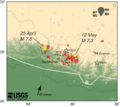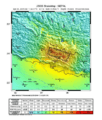April 2015 Nepal earthquake facts for kids
| UTC time | 2015-04-25 06:11:25 |
|---|---|
| ISC event | 607208674 |
| USGS-ANSS | ComCat |
| Local date | 25 April 2015 |
| Local time | 11:56:25 NST |
| Magnitude | 7.8 (Mw) or 8.1 |
| Depth | 8.2 km (5.1 mi) |
| Epicenter | 28°13′48″N 84°43′52″E / 28.230°N 84.731°E |
| Type | Thrust |
| Areas affected | |
| Total damage | $10 billion (about 50% of Nepal's nominal GDP) |
| Max. intensity | VIII (Severe) |
| Aftershocks | 7.3 Mw on 12 May at 12:50 6.7 Mw on 26 April at 12:54 459 aftershocks of 4 Mw and above as of 24 May 2016 |
| Casualties | 8,857 dead in Nepal and 8,964 in total 21,952 injured 3.5 million homeless |
The April 2015 Nepal earthquake, also called the Gorkha earthquake, was a very strong natural disaster. It happened on April 25, 2015, at 11:56 AM local time in Nepal. This earthquake killed more than 8,800 people and injured over 23,000 others.
The earthquake had a magnitude of 7.8, which is very powerful. Its starting point deep underground, called the hypocenter, was about 15 kilometers (9 miles) deep. The spot on the surface right above it, called the epicenter, was east of the Lamjung district.
This earthquake was the worst natural disaster to hit Nepal since 1934. It caused a huge avalanche on Mount Everest, where 19 people died. This made April 25, 2015, the deadliest day ever on the mountain. Another big avalanche happened in the Langtang valley, where 250 people went missing.
Hundreds of thousands of people lost their homes because entire villages were destroyed. Many old buildings, some hundreds of years old, were also ruined. These included important historic sites in the Kathmandu Valley that are recognized by UNESCO. Experts had warned for many years that Nepal was at risk of a major earthquake.
Contents
Understanding the Earthquake
What is an Earthquake?
An earthquake is when the ground shakes. This happens because large pieces of the Earth's outer layer, called tectonic plates, move. These plates are always moving slowly. Sometimes, they get stuck and pressure builds up. When they finally slip, it causes an earthquake.
Why Nepal is at Risk
Nepal is located where the Indian tectonic plate is pushing under the Eurasian plate. This constant pushing creates a lot of stress in the Earth's crust. This stress can lead to powerful earthquakes, like the one in 2015.
The Impact of the Gorkha Earthquake
Damage and Loss
The earthquake caused a lot of damage. Over 8,800 people died, and more than 23,000 were hurt. About 3.5 million people lost their homes. The total damage was estimated to be around $10 billion. This was about half of all the money Nepal makes in a year.
Historic Sites Destroyed
Many famous and ancient buildings were destroyed. These included temples and palaces in the Kathmandu Valley. These sites were important parts of Nepal's history and culture. Their loss was a big blow to the country's heritage.
Avalanches and Landslides
The shaking ground also caused other dangers. It triggered huge avalanches, especially in the mountains like Mount Everest. It also caused many landslides. Landslides are when large amounts of rock and soil slide down a slope. These can block roads and bury homes.
Aftershocks and Continued Dangers
What are Aftershocks?
Aftershocks are smaller earthquakes that happen after a big one. They can continue for days, weeks, or even months. Aftershocks happen as the Earth's crust settles down after the main earthquake.
Aftershocks in Nepal
After the main earthquake on April 25, 2015, Nepal had many aftershocks. One strong aftershock with a magnitude of 6.7 happened the very next day. There were hundreds of aftershocks that were magnitude 4 or higher. These aftershocks made rescue efforts harder and caused more damage to already weakened buildings.
Ongoing Risks
Even after the shaking stopped, the risk of landslides continued. The ground was unstable from the earthquake. This meant that heavy rains could easily cause more landslides, putting people in danger again.
Images for kids
-
Fatality reports by the media as a function of time, compared to the QLARM calculation (horizontal line) made after the rupture area of the Kathmandu earthquake had been mapped. Uncertainty extent given by the vertical solid line. The source for news reports is the NINTRAS web site of the Swiss Seismological Service. All reports, including lower values exceeded by others, are given.
See also
 In Spanish: Terremoto de Nepal de abril de 2015 para niños
In Spanish: Terremoto de Nepal de abril de 2015 para niños










